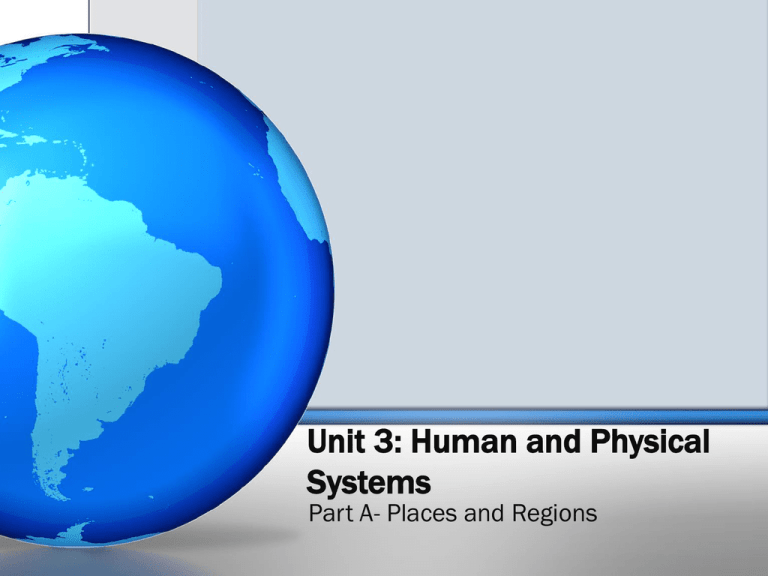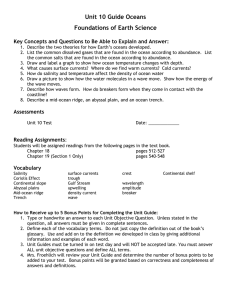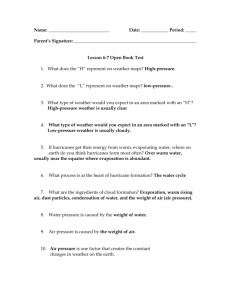Culture in Europe
advertisement

Unit 3: Human and Physical Systems Part A- Places and Regions Lesson 1 •PHYSICAL AND HUMAN CHARACTERISTICS •Places and Regions • Regions can be defined in different ways. • • Geographic features and human criteria are a couple of ways to define a region. Different kinds of geographic features and ways to define a region are explained in more detail on the slides to follow. •Physical Characteristics • Physical characteristics often play a role in defining a region. • • For example, a region might be defined by its geographic features. Listed below, and on the following slide are examples of different physical features. • A delta is the end of a river where the dirt (silt) builds up, often making a fan-shaped area. • A desert is a very dry area usually with few plants and a lot of sand. • A mountain is a very tall, high natural place on the Earth—higher than a hill. •Physical Characteristics • A peninsula is a piece of land that has water on three sides. • A plain is a flat area of land with few trees and few plants. • A rainforest is a climate region usually found near the Equator that gets heavy rainfall year round. • A valley is a low area that can be found in the mountains or between hills. • A coastal area is the area where a piece of land meets a body of water. •Physical Characteristics • North America has many different geographical regions. • The map to the left shows how physical characteristics can define regions. •Human Characteristics • Human characteristics can also define a region. • Listed below are examples of different human characteristics. • Ethnicity can be defined as cultural background. • People who have a similar cultural background might all live in the same area. • The economic activities of people who live in a certain area can be used to define that region. • People who have similar religious beliefs tend to live near one another. • Many areas in the United States could be defined by the religion of the people living in that area. • At times, whole communities are made up of mostly people from the same religious background. •Video: Regions Video: Regions Lesson 2 •CLIMATE AND OCEAN CURRENTS •CLIMATE •Climate • • A climate is a set of weather conditions that exist in a particular region. There are different climates in different parts of the world. • The map below shows the world climatic zones. •General Facts about Climate • • • • Climates located near the equator are usually warm and wet. A desert climate tends to be dry and hot during the day and much cooler at night. A continent or country can have a wide range of climates. Climate affects the type of crops that can be grown in an area. • For example, rice needs warm temperatures and large amounts of rain to grow. • Many Asian countries have hot temperatures and large amounts of annual rainfall. • This provides the right climate to grow rice. •Different Types of Climate • • Elevation can affect the climate of a region. • Elevation refers to the height of a geographical location above sea level. • For example, Denver, Colorado, is called the "Mile High City." This is because Denver is at an elevation that is a mile above sea level. • Places with a high elevation are usually cold. Ocean currents can also affect the climate of an area. • • • For example, a warm current can keep temperatures mild even in a mountainous area. The rainforests of Brazil have a warm and rainy climate throughout the year. •Different Types of Climate • In the areas of northern Canada that have an arctic climate, a biome known as tundra exists. • • The temperate forests of Russia have wet winters and dry summers. • • In the tundra, the ground is always frozen, and very few types of plants or animals can live there. They are home to conifers, lichens, and deer. The Chihuahuan, Sonoran, Mojave, and Great Basin are the major deserts in North America. • These areas are very hot and very dry throughout the year. •European Climate •European Climate • Southern Europe • Southern Europe has a Mediterranean climate because it is most affected by the Mediterranean Sea. • Despite its name, the Mediterranean climate can exist in other parts of the world, such as the west coast of the United States. •European Climate • Eastern Europe • Eastern Europe has a cold continental climate. Unlike western Europe, this part of the continent is too far from the ocean to benefit from warm currents, so its climate is more affected by the region's northern latitude. • •European Climate • Western Europe • Western Europe has maritime and Mediterranean climates, keeping the region warmer than other areas at the same latitude are. The North Atlantic Drift causes this favorable climate by bringing warm air and rain to western Europe. • •Video- Geography Basics: Climate, Water, etc. • Geography Basics: Climate, Water, etc. •OCEAN CURRENTS •Ocean Currents • • Ocean currents are movements of ocean water that flow in a steady direction. Currents can be hot or cool and often affect the weather and living conditions of an area. • Some currents keep temperatures mild in areas that might otherwise be uninhabitable. •Types of Ocean Currents • Upwelling currents: brings a flow of cold water from the bottom of the ocean to its surface. • • This current is affected by the Earth's rotation and seasonal winds. Deep water currents: forms when ocean water flowing into Earth's cool regions (near the North and South poles) cools or freezes. • The cooled or frozen water becomes heavy and sinks to the ocean's depths. •Types of Ocean Currents • Warm surface currents: flow from Earth's tropic regions into northern waters. • These currents are affected by atmospheric winds and the Earth's rotation. • Western boundary currents: warm, fast currents that flow from tropical to temperate regions. • • This current is an example of a warm surface current. Cold surface currents: flow from cooler regions toward the equator. • They are affected by atmospheric forces. •Types of Ocean Currents • Most currents reoccur, which means that all of the conditions are in place to recreate the current over and over again. • Since currents reoccur, many of the currents have been named. • The Somali Current and the East Australian current are two currents located in the oceans of the Eastern Hemisphere. •Types of Ocean Currents • The map below shows the location of the main ocean currents. •Types of Ocean Currents • • The Gulf Stream Current is a major current in the Atlantic Ocean. • It picks up warm water from the North Equatorial Current before heading north along the East Coast. • It then flows out into the northern Atlantic Ocean. The North Atlantic Current (also called the North Atlantic Drift) is a warm water current that brings water from the Gulf Stream to northern Europe. • Because of this current, parts of northern Europe have mild climates despite the fact that the areas are so far north. •Video: Oceans and Seas • Oceans and Seas Lesson 3 •CULTURE •Culture • Culture includes language, traditions, religion, art, music, literature, and even sports. • The next several slides are some of cultural characteristics of regions in Europe. •Culture in Europe • • • Religion Roman Catholicism: a form of Christianity that is widely practiced in western, southern, and parts of Eastern Europe. • The base of the Roman Catholic Church is Vatican City, which is located in Rome, Italy. • Roman Catholicism was the primary form of Christianity in Europe until Protestantism took form during the Reformation. Eastern Orthodoxy: a form of Christianity that is widely practiced in eastern and southeastern Europe. • The Orthodox Church separated from the Catholic Church in 1054 over disagreements between the pope in Rome and the patriarch in Constantinople (present-day Istanbul). • The Orthodox Church has influence in countries like Russia and Greece because Constantinople is closer geographically to them. •Culture in Europe • Religion • Protestantism: a form of Christianity that is widely practiced in western and northern Europe. • The Protestants broke from the Catholic Church during the Reformation, which began in 1517. • • • There are many divisions within Protestantism today. In Europe, the largest Protestant groups are Lutherans, Anglicans, and Calvinists. Judaism: the religion of the ancient Hebrew people that was the first monotheistic (belief in one God) faith. • The Jewish population in Europe has never been very large because Jews immigrated to Europe in smaller groups. • The Jewish population in Europe was persecuted and attacked for much of its history. •Culture in Europe • Religion • Islam: a religion that believes Muhammad was the last and greatest prophet of Allah (God). • Historically, Islam has ties to Spain and the former Ottoman Empire in southeastern Europe, though the Muslim population is growing in other countries (especially France). •Culture in Europe • Languages • Nearly all of the languages in Europe are in the IndoEuropean language family. • Greek, Romance, Germanic, and Slavic languages are the four main branches of the Indo-European languages which are used today. • Greek is in its own category. • Romance languages formed out of the Roman Empire's Latin. • Romance languages include Italian, Spanish, Portuguese, and French. •Culture in Europe • Languages • Germanic languages can be traced back to a language that goes back to 500 B.C. • • Germanic languages include German, Dutch, and English. Slavic languages are languages that, today, are spoken in eastern Europe and northern Asia. • Slavic languages include Russian, Polish, and Serbian. •Culture in Europe • Literature • Europe's history of literature is very rich. The Nobel Prize in Literature is given each year in Sweden. Many European authors have won this award, including Rudyard Kipling (1907). • • • Kipling was born in India when it was controlled by the British Empire. • Many of his stories were influenced and impacted by his life in India and England. •Culture in Europe • Art • Europe has had many different painters who used different styles. • Pablo Picasso, a Spanish artist, painted in the early 20th century. • He is most well-known for cubism, a form of abstract art. • Abstract art, including cubism, is a style in which the pictures are not meant to be realistic. •Culture in Europe • Art • Another famous painter was Vincent Van Gogh, from the Netherlands. • Van Gogh was a post-Impressionist artist who painted scenes, landscapes, and still-lifes. • Only one of his paintings was sold while he was alive, but today he is extremely well-known all over the world. •Culture in Europe • Music • Music has been a part of European culture for years. Three styles are distinctly European—classical, opera, and modern musicals. • • Classical music includes artists like Beethoven, Mozart, and Wagner. • Opera is a musical style that began in Italy around the 17th century. • It tells a dramatic story through music and song s on stage. •Culture in Europe • Music • Modern musicals are very similar to opera, though with opera the story is told entirely through song. • Modern musicals tell a story through acting, dancing, and song. • English writer Andrew Lloyd Webber may be one of the most well-known musical writers. • His musicals The Phantom of the Opera and Cats have broken records in England and on Broadway. •Culture in Europe • Sports • The most popular sport in Europe is soccer, which Europeans call football. • • The World Cup is an international event for this sport. Other popular sports in Europe include rugby, cricket, tennis, and basketball. •Culture in Europe • Architecture • Architecture in Europe has been influenced by many different cultures. Countries and regions often have distinct architectural styles that make them different from other places. • • Ancient Greek buildings typically were built with columns. • Ancient Roman architecture is known for using arches and domes. •Culture in Europe Architecture • During the late Middle Ages, many Gothic cathedrals, such as Notre Dame Cathedral in Paris, were built throughout Europe. • St. Basil's Cathedral in Moscow is an example of Russian architecture. • The domes on the roof are an architectural element that is often found in Russian buildings. •Culture in Europe Architecture • Bohemian architecture in Prague, Czech Republic • A canal in Amsterdam, The Netherlands •Video: Culture • The Way We Live- Common Ground: Culture







